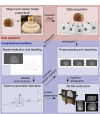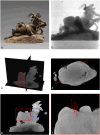Enabling 3D CT-scanning of cultural heritage objects using only in-house 2D X-ray equipment in museums
- PMID: 38744870
- PMCID: PMC11094032
- DOI: 10.1038/s41467-024-48102-w
Enabling 3D CT-scanning of cultural heritage objects using only in-house 2D X-ray equipment in museums
Abstract
Visualizing the internal structure of museum objects is a crucial step in acquiring knowledge about the origin, state, and composition of cultural heritage artifacts. Among the most powerful techniques for exposing the interior of museum objects is computed tomography (CT), a technique that computationally forms a 3D image using hundreds of radiographs acquired in a full circular range. However, the lack of affordable and versatile CT equipment in museums, combined with the challenge of transporting precious collection objects, currently keeps this technique out of reach for most cultural heritage applications. We propose an approach for creating accurate CT reconstructions using only standard 2D radiography equipment already available in most larger museums. Specifically, we demonstrate that a combination of basic X-ray imaging equipment, a tailored marker-based image acquisition protocol, and sophisticated data-processing algorithms, can achieve 3D imaging of collection objects without the need for a costly CT imaging system. We implemented this approach in the British Museum (London), the J. Paul Getty Museum (Los Angeles), and the Rijksmuseum (Amsterdam). Our work paves the way for broad facilitation and adoption of CT technology across museums worldwide.
© 2024. The Author(s).
Conflict of interest statement
The authors declare no competing interests.
Figures






References
-
- Morigi MP, Casali F, Bettuzzi M, Brancaccio R, D’Errico V. Application of X-ray computed tomography to cultural heritage diagnostics. Appl. Phys. A. 2010;100:653–661. doi: 10.1007/s00339-010-5648-6. - DOI
-
- Vandenbeusch M, O’Flynn D, Moreno B. Layer by layer: the manufacture of Graeco-Roman funerary masks. J. Egypt. Archaeol. 2021;107:281–298. doi: 10.1177/03075133211050657. - DOI
-
- Dorscheid J, et al. Looking under the skin: multi-scale CT scanning of a peculiarly constructed cornett in the Rijksmuseum. Herit. Sci. 2022;10:161. doi: 10.1186/s40494-022-00800-8. - DOI
Grants and funding
LinkOut - more resources
Full Text Sources

